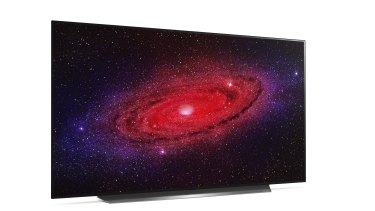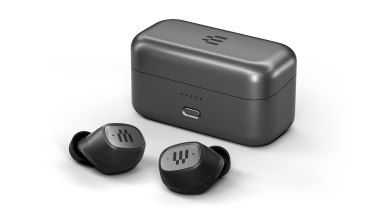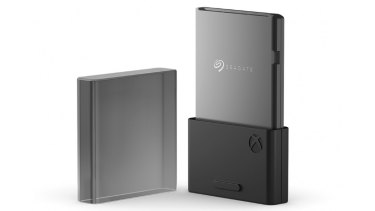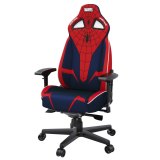Next-gen notwithstanding, you also can’t ignore the incredibly popular $470 Nintendo Switch if you don’t have one already. It can be used with a TV or on the go and has already built a library of hundreds of excellent games.
The just-released Mario Red & Blue Edition marks the first time the core system’s come in anything other than black, it looks incredible and comes with everything you’ll need to get started including a case, two red Joy-Con controllers, a blue grip and a red dock for TV play, and some colourful straps to make sure the controllers don’t go flying.

The Mario Red & Blue Switch gives a new look to Nintendo’s popular system.
What to pay: Don’t spend more than the recommended retail price getting next-gen systems from resellers. Stock’s dribbling out often, so be proactive or wait until later in the year.
Televisions
If you’re looking for a TV to make the most of a next-gen system, you’ll want to ensure it supports HDMI 2.1. The new standard more than triples the bandwidth so games can display up to 120 frames per second at full 4K, while passing high-end audio from the TV to a receiver or soundbar. Many HDMI 2.1 TVs also support variable refresh rate, which helps keep motion smooth even if a game shoots for a high performance target and can’t quite hold it, which I predict we’re going to see happen a lot.

The LG CX is the best current TV for the new consoles.
My current recommendation is the LG CX OLED, a beautiful TV with low input latency that supports all the latest audio and video formats. It sports four full HDMI 2.1 ports, where many other TVs only have one.
What to pay: A good HDMI 2.1 TV will cost at least $2000. The LG CX starts at $2800 for the 48-inch, but a little more should get you to 55-inches. The 65-inch is often around $4000 at retail.
Audio
Positional 3D audio is a big selling point of next-gen, and while new systems happily pump out surround to your speakers or soundbar you’ll want a wireless headset for maximum effect. The best I’ve used is the SteelSeries Arctis 7X; it’s comfortable and works on everything from old and next-gen Xbox and PlayStation consoles to PCs, phones and the Switch in either TV or handheld mode. Unfortunately it’s all-but impossible to find and SteelSeries could only give me a vague “2021” window for when you might get one. I also like the Turtle Beach Stealth 700 Gen 2 headsets which work with either Xbox or PlayStation. The Stealth 600 Gen 2 is a good mid-range option.

The EPOS GTW 270 are surprisingly good gaming earbuds you can also use for general smartphone use.
Earbuds aren’t my first choice for gaming because your ears will get fatigued after a while, but I’ve been very impressed with the EPOS GTW 270. They work wirelessly and lag-free on PlayStation, PC, and Switch in TV or handheld mode, come in a charging case so last around 20 hours, and can switch to Bluetooth to work with your phone.
What to pay: Most good headsets go for between $150 and $300, though the EPOS buds are $350.
Storage
The next-gen systems all have cutting edge solid state drives that enable extremely fast loading and huge seamless worlds. Next-gen games need to run on these drives but they’re expensive, so Microsoft and Sony don’t provide much space. There’s an official Seagate Storage Expansion Card for Xbox that will give you 1TB extra, but it’s a hefty $360. There’s currently no way to expand your space for PS5 games, though it will come eventually.

The official expansion card is an effective but very expensive option for bulking up the storage on your Series X or Series S.
For now if you’re planning to install a lot of games, my advice is to get a fast USB drive. Next-gen specific games can’t run off it, but you can use it to install older PS4 or Xbox, Xbox 360 and Xbox One games. I’m using Seagate BarraCuda Fast SSDs, and loading times are lightning quick.
What to pay: An SSD using USB 3.0 or 3.1 should set you back around $150 for 500GB or $250 for 1TB. Prices skyrocket for 2TB and higher, but storage is frequently discounted on Amazon and elsewhere.
Seating
Ergonomics are important if you’re gaming for long sessions. In a lounge setting there might not be much you can do; just make sure you can sit straight and have the middle of your TV directly in front at eye level to avoid neck strain.

The Anda Seat Spider-Man edition.
If you’re at a desk or table, then a gaming chair is a great investment, and can double as an ergonomic option when working from home. Most have adjustable height, many arm rest positioning options, cushions for lower back and neck support and a lever for reclining. Racing-style chairs from Anda Seat are a popular option, offering everything from plain black chairs to a new line of superhero-themed seats officially licensed by Marvel. They’re very supportive and look great, though some may find the seats a bit shallow. If you want to really sink back, I recommend the OMEN Citadel Gaming Chair.
What to pay: Gaming chairs start around $200, but a really well made one will be $400 or more. The OMEN chair above is $700, while Anda Seat’s Marvel line goes for between $500 and $820.
Technology newsletter
The top technology stories, gadget releases and gaming reviews delivered every Friday. Sign up here.
Tim is the editor of The Age and Sydney Morning Herald technology sections.
Most Viewed in Technology
Loading








